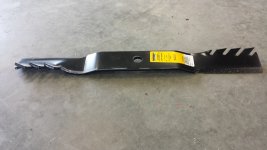boggen
Elite Member
- Joined
- Feb 22, 2011
- Messages
- 3,789
- Location
- Trivoli, IL
- Tractor
- SSTT (Sideways Snake Tain Tractor) and STB (sideways train box) tractor, dirt harvester
see attached picture.

#1's = blade tip speed stays the same, but...
A = slower MPH = less blades of grass cut per rotation of blade.
B = faster MPH = more blades of grass need to be cut per rotation of blade.
#2's belts, and friction / heat they get.
A = belt folds back and forth, and actually twists. belt really does heat up a lot. every wiggled a wire back and forth till it broke into 2 pieces? ((assumption pulley on mower is upward vertical position.))
B = ((assumption pulley on mower is laying horizontal )) belt still needs to be bent back and forth, and twist some.
C = 3 separate belts going to say a hydraulic motor with 3 pulleys on the end of it.
D = hydraulic motor per each blade. all heat / friction is put into the hyd oil and carried away.
other words = the more a belt heats up, the more likely it is to stretch. more stretching = more slipping on pulleys = additional heat.
#3's needing to pull grass up into the blades due to being flatten / ran over before blades get to the grass.
A = riding lawn mower. wider / thicker front tires. and in that more grass is flatten.
B = zero turn mower, caster wheels on front = smaller wheels / tires. that do not flatten grass as much.
overall it takes power to suck and draw blades of grass up into the blades.
other words = blade shape can determined how much suction there is to draw grass up into the blades to be cut. the more suction power there is, the more likely the mower HP is needed to get the blade to spin. and keep it spinning at wanted RPM's
#4's = weight distribution. over drive wheels.
A = riding mower, engine weight for most part over front wheels, while human weight is over rear wheels.
B = zero turn mower, engine weight and human weight kinda balance themselves of the rear drive wheels.
#5's = more of attempt to show a kids "tetter tottor" of #4's
other words = traction, more weight on drive wheels more likely you get more traction vs spinning wheels.
==============
torque and RPMS, and getting the power transferred to the blades constantly, and to tire err making sure you have traction...
i would say riding mowers = not as efficient as a zero turn mower. when comparing cutting grass...
riding lawn mowers = flatten / smash more grass into the ground before blades get to it, belts heat up and slip more, less weight over 2WD rear tires for traction.
zero turns = sharper turns / quicker turns, able to keep eye on were you are driving vs last path (not moving eyes back and forth like on a riding mower)

#1's = blade tip speed stays the same, but...
A = slower MPH = less blades of grass cut per rotation of blade.
B = faster MPH = more blades of grass need to be cut per rotation of blade.
#2's belts, and friction / heat they get.
A = belt folds back and forth, and actually twists. belt really does heat up a lot. every wiggled a wire back and forth till it broke into 2 pieces? ((assumption pulley on mower is upward vertical position.))
B = ((assumption pulley on mower is laying horizontal )) belt still needs to be bent back and forth, and twist some.
C = 3 separate belts going to say a hydraulic motor with 3 pulleys on the end of it.
D = hydraulic motor per each blade. all heat / friction is put into the hyd oil and carried away.
other words = the more a belt heats up, the more likely it is to stretch. more stretching = more slipping on pulleys = additional heat.
#3's needing to pull grass up into the blades due to being flatten / ran over before blades get to the grass.
A = riding lawn mower. wider / thicker front tires. and in that more grass is flatten.
B = zero turn mower, caster wheels on front = smaller wheels / tires. that do not flatten grass as much.
overall it takes power to suck and draw blades of grass up into the blades.
other words = blade shape can determined how much suction there is to draw grass up into the blades to be cut. the more suction power there is, the more likely the mower HP is needed to get the blade to spin. and keep it spinning at wanted RPM's
#4's = weight distribution. over drive wheels.
A = riding mower, engine weight for most part over front wheels, while human weight is over rear wheels.
B = zero turn mower, engine weight and human weight kinda balance themselves of the rear drive wheels.
#5's = more of attempt to show a kids "tetter tottor" of #4's
other words = traction, more weight on drive wheels more likely you get more traction vs spinning wheels.
==============
torque and RPMS, and getting the power transferred to the blades constantly, and to tire err making sure you have traction...
i would say riding mowers = not as efficient as a zero turn mower. when comparing cutting grass...
riding lawn mowers = flatten / smash more grass into the ground before blades get to it, belts heat up and slip more, less weight over 2WD rear tires for traction.
zero turns = sharper turns / quicker turns, able to keep eye on were you are driving vs last path (not moving eyes back and forth like on a riding mower)

